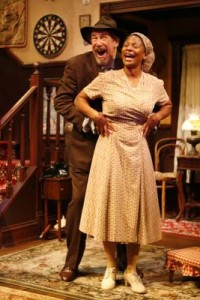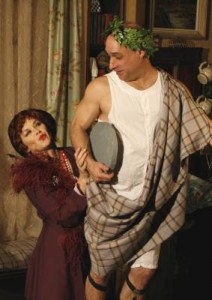
Kaufman and Hart’s 1930s You Can’t Take It With You is probably my all-time
favorite comedy classic, and any chance to see a production of it is one I can’t
pass up. In years past I’ve seen excellent revivals by (among others) the Colony,
Actors Co-Op, and the Geffen, and I’ve watched the video of the 1983 Broadway
revival more times than I can count. I even got to fulfill an actor’s dream by
portraying Mr. Kolenkhov at the Center Theater in Whittier earlier this year. Thus,
you can imagine what a treat it was for me to see the Rubicon Theatre
Company’s production of this screwball gem.
Director Jenny Sullivan and her marvelous cast of 18 have put together a splendid
revival which will surely be enjoyed by diehard YCTIWY fans like myself, and
newbies as well.
For the uninitiated, You Can’t Take It With You is the story of an charmingly
eccentric family, the Vanderhoff/Sycamores, who reside together in perfect, if
oddball, harmony in a large New York City home. Patriarch Martin aka Grandpa
(Robin Gammell) quit Wall Street decades ago because he “wasn’t having any
fun.” His daughter Penny writes plays because a typewriter was delivered to their
house by mistake eight years ago. Granddaughter Essie longs to be a dancer,
though even her Russian émigré ballet instructor Mr. Kolenkhov opines that “she
stinks.” Penny’s husband Paul, together with lodger Mr. DePinna, makes fireworks in
the basement while Essie’s husband Ed plays the xylophone and delivers Essie’s
homemade candies (called “Love Dreams”) with hand-printed circulars inside.
(The circulars feature quotes by Trotsky proclaiming that “God is the state, the
state is God,” not because Ed believes in them but simply because the words are
short and easy to print.) African-American maid Rheba cooks meals of “cornflakes
and some kind of meat,” while her unemployed boyfriend Donald is out catching
flies to feed to the family’s pet snakes.
Just as Marilyn Munster was the only “normal” one in her family, so too is Alice
Sycamore the sore thumb in the Vanderhoff/Sycamore home. Lovely Alice, who
has a humdrum day job working for a Wall Street banker, has fallen in love with his
handsome son Tony. As much as Alice loves her family, she is equally embarrassed
by them, and wants Tony to get to know them “in small doses.” When Tony and his
parents arrive for a painstakingly planned dinner party at the Sycamore’s—on the
wrong night, the stuffy Mr. Kirby and his oh-so-proper wife Marian are in for an
evening of surprises.
The secret to a great You Can’t Take It With You is in the casting, and director
Sullivan has assembled a terrific cast. Robin Pearson Rose is perfection as Penny.
Pearson knows that to get the most laughs, Penny must be played straight, and
laughs she does get with her dry offhand delivery of lines like, “You mustn’t count
the first eight years (of playwriting) because I was learning to type.” Leonard Kelly
Young creates a Paul so full of joy that the audience can’t help but share his
enthusiasm for his firework extravaganzas. Any actor who can move from the title
role in Hamlet to the adorably dim Ed is a master of versatility, and Joseph Fuqua is
just such an actor. Sonia Sanz has oodles of fun as Essie, who is to ballet as Florence
Foster Jenkins was to opera. Sanz’s Essie is not only an uproariously bad, albeit
earnest, dancer, but a clumsy one as well, bumping into furniture and family
members alike. Jamie Torcellini couldn’t be better as Mr. DePinna, who came to
the Sycamore home one day and just stayed and stayed. Collette Porteous and
Ovation winner Chris Butler take the potentially offensive (to 2007 audiences)
African American stereotypes of the 1930s and play them with dignity and verve.
The only sore note is a crotchety Grandpa Vanderhoff who fails to provide the
contagious “joie de vivre” that is so essential to the role.
As Mr. Kolenkov, Paul Ainsley is an adorably big and burly Russian bear of a ballet
instructor. As much as I enjoyed playing Kolenkhov myself, I felt equal joy in
watching Ainsley make this over-the-top maestro his own.
Then there are the young lovers, Alice and Tony, the only “straight” characters in
the play. Winslow Corbett, a lovely and spunky heroine, shows much comedic
charm, and cries real tears in her romantic scenes with Rick Cornette, a standout
as her betrothed. Cornette, quite possibly musical theater’s handsomest leading
man, proves himself equally adept at song-free romantic comedy, giving us a Tony
who is both debonair and a charmingly awkward boy-next-door.
Tony’s parents Mr. and Mrs. Kirby are brought to stuffy, snooty life by George
Backman and Allison Coutts-Jordan. Backman is superbly self-important as banker
Kirby, and wait till you see the dirty look Coutts-Jordan gives him when he suggests
returning to the Vanderhoff/Sycamore house the night after their unexpected
arrival.
One of the delights of any production of YCTIWY are the cameo roles Kaufman
and Hart created for each of the play’s three acts. Dan Gunther, looking much
like 1930s character favorite Franklin Pangborn, with period-perfect glasses, pencil
mustache, and slicked down hair, is hysterical as IRS agent Wilber C. Henderson,
who becomes steadily more frustrated at Grandpa’s refusal to pay his income tax.
Stephanie Zimbalist milks every laugh imaginable as she reinvents blowsy drunken
actress Gay Wellington (as channeled through Lucille Ball). Zimbalist returns in the
final act as a much more subdued Olga Katrina (Grand Duchess slash Waitress at
Child’s Restaurant).
The cast is nicely rounded out by Rudolph Willrich, Gregory Johnson, and Zack
Neely as the three G-men, or as Penny calls them, J-men. (I loved Willrich’s
slapping Ed with Ed’s own circulars!)
Director Jenny Sullivan adds many fine and funny touches to the production, yet
keeps her actors reality based.
The Rubicon’s production looks great. Gary Wissman has designed a wonderfully
detailed set, complete with printing press, xylophone, and dart board. Lighting
designer Thomas S. Giamario and sound designer David Beaudry deserve special
credit for their offstage fireworks effects. Shon LeBlanc does his usual fine work with
period fashions, though 1930s wigs would have completed the vintage effect
better than the rather contemporary hairstyles worn by the women.
Ultimately, You Can’t Take It With You succeeds, decade after decade, because
of Kaufman and Hart’s perfectly constructed script, brilliantly eccentric
characters, and optimistic message: no matter how hard times may be, family,
friends, and joy for living give meaning—and hope—to life! This production at the
Rubicon ranks as among the very best I’ve seen.
Rubicon Theatre, 1006 E. Main St., Ventura.
–Steven Stanley
November 17, 2007
Photos: Andrea Johnston




 Since 2007, Steven Stanley's StageSceneLA.com has spotlighted the best in Southern California theater via reviews, interviews, and its annual StageSceneLA Scenies.
Since 2007, Steven Stanley's StageSceneLA.com has spotlighted the best in Southern California theater via reviews, interviews, and its annual StageSceneLA Scenies.







 COPYRIGHT 2024 STEVEN STANLEY :: DESIGN BY
COPYRIGHT 2024 STEVEN STANLEY :: DESIGN BY